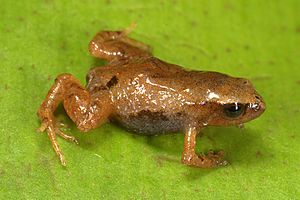Strabomantidae facts for kids
Quick facts for kids Strabomantidae |
|
|---|---|
 |
|
| Noblella pygmaea | |
| Scientific classification | |
| Kingdom: | |
| Phylum: | |
| Class: | |
| Order: | |
| Suborder: | |
| Family: |
Strabomantidae
Hedges, Duellman & Heinicke, 2008
|
| Subfamilies | |
|
|
The Strabomantidae are a special family of frogs. These amazing amphibians live in South America. They are found in many different habitats, from mountains to forests.
What makes these frogs unique is their life cycle. Most frogs lay eggs that hatch into tadpoles. These tadpoles live in water and slowly change into frogs. But Strabomantidae frogs are different! They do not have a free-living larval stage. This means their babies do not live as tadpoles in water. Instead, their eggs hatch directly into tiny "froglets." These froglets look just like miniature adult frogs. This special way of growing helps them live in places without much standing water.
Contents
Understanding Frog Families: Strabomantidae Groups
Scientists group living things into families to understand them better. This is called Systematics. The Strabomantidae family is divided into two main groups, or subfamilies. These groups are called Holoadeninae and Strabomantinae. Each subfamily contains different types of frogs that share similar features.
Holoadeninae Frogs
The Holoadeninae subfamily includes several kinds of frogs. Some well-known groups in this subfamily are Barycholos, Bryophryne, and Noblella. These frogs often live in cooler, higher places. They are known for their unique adaptations to these environments.
Strabomantinae Frogs
The Strabomantinae subfamily is much larger. It contains many different types of frogs. Some examples include Pristimantis and Oreobates. Frogs in this group are found in a wide range of habitats. They show a lot of variety in their size, color, and behavior.
Where Strabomantidae Frogs Live
These frogs are found only in South America. They live in various countries across the continent. You can find them in places like the Andes Mountains and tropical rainforests. Their ability to hatch directly as froglets helps them survive in many different environments. This includes places where ponds or streams might dry up.

